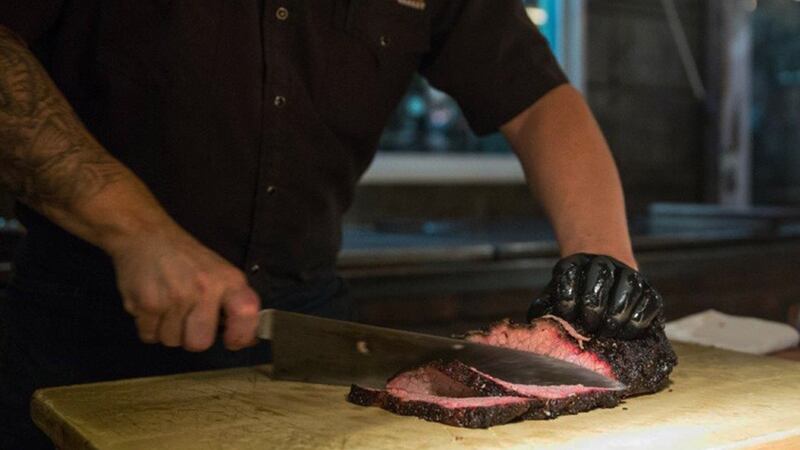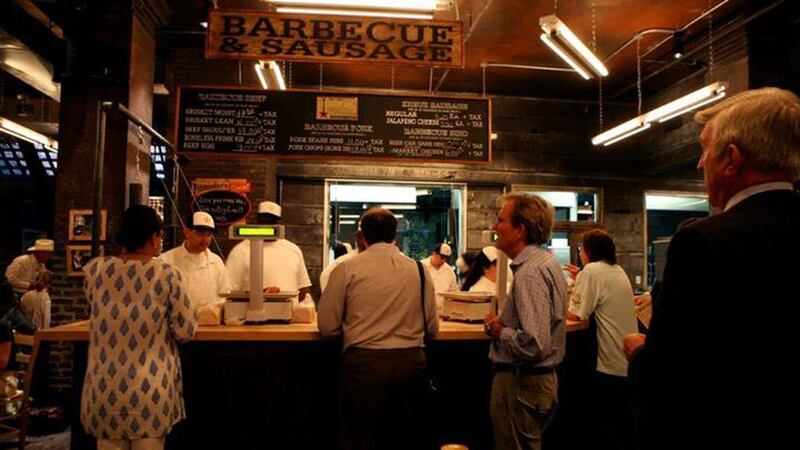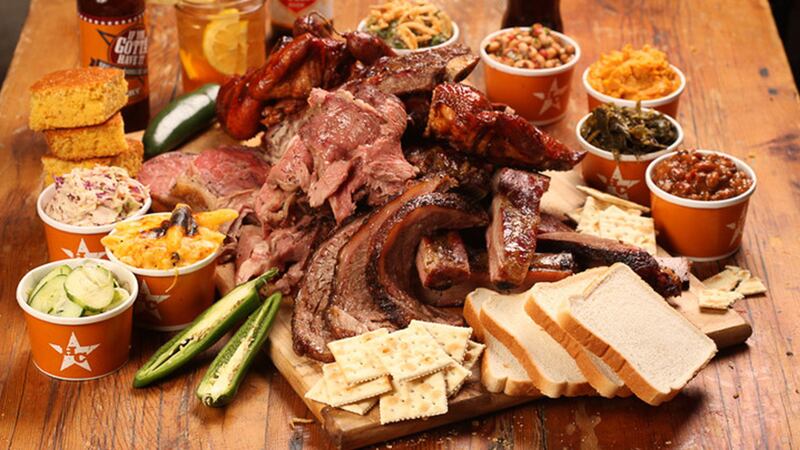Hill Country Barbecue Market was conceived from my longing for a romanticized place from my childhood. It’s a brick-and-mortar love letter to my family. Growing up in the cloistered suburbs of Washington, D.C., the son of two native Texans, I cherished my frequent trips to the Lone Star State to visit my extended family, including many assorted cousins, who instilled in me from an early age that everything is bigger and better in Texas.
No memories proved more indelible and enduring from those numerous winter breaks and summer holidays than family gatherings in my dad’s hometown of Lockhart. The Glosserman’s roots in the area extend back four generations, and for most of that time my family has been friends with the Schmidt family—the third-generation owners of Kreuz Market. The legendary barbecue joint started out as a grocery store in 1900 and evolved into a full-fledged restaurant in the 1960s.
A trip to Kreuz, originally located off the historic town square, was always something of a Glosserman family tradition. Approaching the restaurant by car, blocks away we’d catch a whiff of the smoky post oak aromas. The walls of the long entry hallway were covered in a dark amber patina of smoke and grease that had accumulated over decades. My younger brother and I would giddily make our way to the pit room where the smoke progressively thickened, the heat steadily rose and our stomachs increasingly growled with anticipation.
ADVERTISEMENT
The excitement culminated at the meat counter, where we watched the lamb-chopped, blade-wielding man behind the butcher block pull hulking pieces of meat from the pits and deftly carve them to order. The slices and links would be scooped onto a giant scale, weighed, transferred to butcher paper, wrapped and handed over to my brother and I to carry to our table in the dining room. We’d enjoy this steaming bounty accompanied by soft, pliable white bread, saltine crackers, sweet pickles and hunks of “yellow” cheese. Grandparents, aunts, uncles and cousins would gather around long wooden tables to feast on hot peppery sausage links, perfectly smoked brisket and succulent prime rib.

These meals were the inspiration for my New York restaurant Hill Country. My goal was to recreate these iconic food memories and construct a place where families and friends could eat together while enjoying a century-old culinary art. The food had to be authentic and delicious and second helpings would be standard.
At the time, I was living in London, having moved there three years prior to launch and run the European office of a telecommunications company I had co-founded with three childhood friends. I had recently separated from that business and decided that I was ready to move back to the U.S. and give New York a try. I arrived in the city in February of 2004 and two months later had a chance meeting with my future wife, Kristen, while on the subway. Kristen would become instrumental in the launch and success of Hill Country.
As the idea for Hill Country came together in my mind, I approached Rick Schmidt, the owner of Kreuz at the time and a close elementary and high school friend of my dad’s. I originally asked Rick if he would consider partnering with me on a restaurant in New York. He ultimately demurred but told me that as long as I was “jumping into the frying pan” he would be supportive. Rick and the Kreuz team generously opened their doors to us sharing designs, recipes and even helping to train some of our staff. Rick’s son, Keith, now operates Kreuz, and we still purchase their sausage links, which we serve in all three of our barbecue restaurants.
I signed the lease for a space at 30 West 26th Street a few days after getting married and while Kristen and I were on our honeymoon in Paris. Design, development, and construction of the restaurant lasted twelve months, and on June 1, 2007, exactly one year to the day after entering into a lease, Hill Country opened its doors for the first time to friends and family.
In what has become something of Hill Country folklore, I missed opening night when Kristen went into labor late in the afternoon and gave birth to our first child, Austin Sam, that evening.
At the time Hill Country opened, a wave of new barbecue joints had overtaken the city. Big names like Blue Smoke, Dinosaur BBQ, Daisy May’s, and RUB were making headlines with quality offerings and expanding New York’s barbecue scene, which still was in its relative infancy. What fortunately differentiated Hill Country was its focus on the style of barbecue served in Central Texas. Most of the other barbecue joints that were around at the time featured an amalgam of various regional styles, so it would be common to see Memphis-style ribs, North Carolina-style pulled pork and Texas-style brisket on the same menu.
Hill Country’s singular focus introduced many New Yorkers, who commonly associated barbecue with baby back ribs and sweet and tangy sauces, to a less familiar style of ‘cue in which beef is king and dry rubs consisting of kosher salt, course black pepper and a little cayenne is all that seasons the meat. It also introduced to Manhattan the concept of the market counter, where guests stand in line to order by the pound and eat off of butcher paper. I think we also helped elevate the status of the pit master, whose job is to lord over the barbecue in full view of everyone in the restaurant.
More than the food, I wanted Hill Country to be a transportive experience for our guests once they crossed the threshold. For Texas expats and displaced Southerners, the restaurant was supposed to feel like a familiar place from back home where they could kick back or have a good time. For New Yorkers and the Central Texas barbecue uninitiated, Hill Country was to be a place of discovery where they could find out what all the fuss surrounding Texas barbecue was about. We went to extreme lengths to achieve a sense of authenticity by sourcing food and beverage products from Texas, including importing post oak wood by the truckload to use in our smokers.
I didn’t want guests to have to pay at the counter à la a cafeteria (which would also slow down the lines), so we developed a meal ticket, which is a small, heavy-stock card about the size of an oversized iPhone, which has the main food and beverage offerings printed on it. (It’s presented to and marked up by the counter servers during the ordering process.) It then doubles as a check when the server or cashier uses it at the end of the meal to figure out how much to charge the guest.

While somewhat of a nod to the paper cards used at Big Apple institution Katz’s Deli, the meal ticket system is one of Hill Country’s biggest innovations and also one of the most controversial aspects of the restaurant. The meal ticket has its fans and its detractors, and it seemed that almost everyone had an opinion about it. We had accomplished the unthinkable: a New York restaurant where waiting in line was part of the experience.
Another major (and expensive) hurdle was structurally reinforcing the floors of our old Garment District building to support 12,000 pounds of fully-loaded smoking equipment and installing an exhaust system that included three separate flus and extends up 12 floors. We ran into some serious budget issues during our construction and ended up doing as much as we could on a shoestring, which resulted in the restaurant having lots of DIY touches. Materials like reclaimed wood, second-hand Southern antiques, meticulously sourced artifacts and tubular filament bulbs (which were not widely used in restaurants at the time), helped create an aesthetic that projected authentic warmth and comfort while simultaneously offering something new and forward-looking in design.
Our opening team was eager and enthusiastic even if somewhat lacking in experience—I’m especially talking about myself. I had no prior personal or family experience in the restaurant business aside from my first summer job making pizzas at Domino’s when I was 16. I was fortunate to meet four people, however, who had major rolls in the development of Hill Country: John Shaw (Operating Partner and COO for nine years), Elizabeth Karmel (Hill Country’s first Executive Chef), Robbie Richter (opening pitmaster) and Garrett Singer (our architect and designer).

We spent months writing training manuals, procuring product, designing logos and uniforms, trying recipes in test kitchens and backyards, and sweating hundreds of other details large and small. When it got around to recruiting, we hired mostly for personality and a cultural fit. John Shaw, who led operations, brought to our homey barbecue spot some of the finer points of hospitality that he had picked up from his career dating back nearly twenty years. Our goal was to provide a level of hospitality that “felt like a warm hug” to every guest who came through our doors.
Hill Country proved to be a pretty big hit out of the gate. Although we were prone to gross inconsistencies and often sold out of some of our most popular items, on the whole we were putting out a solid product in those early days. Early blog reviews were mostly favorable with some scattered raves. A “$25 and Under” review in the New York Times that appeared a couple weeks after we opened noted that “no other barbecue place that has opened in New York in recent years has gotten it so right, right out of the gate.”
The buzz was building, and it reached a crescendo in mid-July when the Wall Street Journal included Hill Country in its list of the “Top 10 Barbecue Restaurants in the United States.” That was a tremendous stamp of approval and, looking back, a major turning point for the brand we were building.
Ten years later we have served nearly 1.5 million pounds of brisket, 700 thousand pounds of pork ribs, 100 thousand pounds of mac & cheese and burned through approximately 400 thousand cords of post oak at our flagship restaurant. We have hosted hundreds of weddings and rehearsal dinners, countless celebrities, politicians and athletes, and produced performances by dozens of Grammy Award-winning acts. We have garnered two coveted stars from the New York Times and been featured regularly on the Food Network, the Cooking Chanel and several nationally televised shows. We have expanded our brand into Washington, D.C. and Brooklyn, launched a fried chicken concept, produced four American Roots showcases at SXSW in Austin, opened concessions at Madison Square Garden, the U.S. Open at the USTA Center, Lincoln Center and the National Building Museum, and cooked at food festivals countrywide. The Hill Country brand has stretched far beyond our borders and far beyond my dreams.

Time marches forward, and much has changed in a decade. For starters, there is a lot more quality barbecue out there today than when we got started. Texas has undergone a barbecue renaissance, and New York has turned into a bona fide barbecue town in its own right with new spots opening regularly that continue to raise the bar and offer new twists on the cuisine.
Additionally, our sleepy, off-the-beaten path neighborhood that existed between east Chelsea and north Flatiron has transformed into 24/7 culinary behemoth that can compete with the likes of any in the country for restaurant preeminence. From a business perspective, the sword cuts both ways. While there are many more workers and residents in the neighborhood than there were ten years ago, the competition has become much fiercer as well. The challenge to evolve (we now offer a pulled pork sandwich as well as a pepper jelly-glazed baby back rib special) and improve (we upgraded our brisket specs from Choice to Certified Angus Beef a couple years ago) is ever-present.
It is hard to believe that a decade has gone by since we first opened the doors on West 26th Street. Over the years, we have veered off in certain directions and taken risks to grow the business in others, but we have consistently tried to improve our core offering and stay true to ourselves. While many of the faces have changed and some of the furniture has been rearranged, Hill Country in 2017 is much the same restaurant that it was in 2007. We still serve the same craveable brisket, mac & cheese, and cornbread as we did back then.
One of my favorite musicians, Bob Schneider, proclaimed to the crowd after a blistering bluegrass set in Austin I attended several years ago, “Easier than it looks—harder than you'll ever know!” The same could be said of the restaurant business.
To survive and thrive in Manhattan for a decade is an improbable feat. To think about all of the blood, sweat, and tears, and all the joyous moments in between, I am grateful beyond words for the opportunity to have served so many guests far and wide, to have served our community proudly, and to have served alongside so many talented, dedicated, and hard-working people on the Hill Country team. This 10th Anniversary is a momentous milestone, and I eagerly look forward to what the next ten years have in store.
Marc Glosserman is the founder of New York’s Hill Country Barbecue Market.





